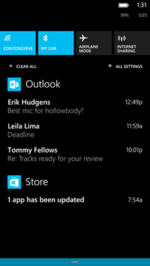
Bing for mobile is a search tool for handheld mobile devices from Microsoft as part of their Bing search engine. It is designed for mobile device displays. Bing Mobile is built into Windows Mobile and Windows Phone as proprietary software, accessed via the Search key on Windows Phone 7 and Windows Phone 8 devices. It is also available on Windows Phone 8.1, and can be downloaded for other platforms, including and Android.
Nokia phones beta labs is a service in which beta software for Nokia smartphones are available for public download. The service was originally launched as Nokia Beta Labs in 2007 by Nokia for S60-based Symbian devices, and later for the company's Windows Phone-based Lumia line. After the sale of the Nokia mobile devices division to Microsoft, the website was renamed Lumia Beta Apps. It was discontinued in 2015. The service was revived by HMD Global in 2017 for Nokia Android smartphones, allowing members to test Android 8.0 Oreo beta.

Windows Phone (WP) is a discontinued mobile operating system developed by Microsoft for smartphones as the replacement successor to Windows Mobile and Zune. Windows Phone featured a new user interface derived from the Metro design language. Unlike Windows Mobile, it was primarily aimed at the consumer market rather than the enterprise market.
This page provides details for the version history of the Microsoft's Windows Phone branded mobile operating systems, from the release of Windows Phone 7 in October 2010, which was preceded by Windows Mobile version 6.x.

The Nokia Lumia 800, which was codenamed 'Sea Ray', is a smartphone that was launched by Nokia on October 26, 2011, at the Nokia World 2011 event. Initially, it operated on Snapdragon S2 processor and Windows Phone 7.5 "Mango" and was the first device manufactured by Nokia to run on the Windows Phone operating system. This marked a significant shift for the company from using Symbian for their smartphones. Upon its original release in November 2011 in Europe, it was Nokia's flagship product and was hence a crucial product for their mobile phone business.
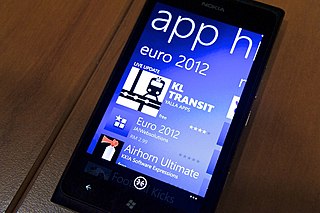
The Nokia Lumia 900 is a Windows Phone-powered smartphone, first unveiled on January 9, 2012, by Nokia at Consumer Electronics Show 2012, where it won the Best Smartphone award in January 2012. The phone has 4G LTE support and was released in April 2012. The Lumia 900 was the flagship smartphone of the Lumia range until the release of its successor, the Lumia 920.

Windows RT is a mobile operating system developed by Microsoft. It is a version of Windows 8 or Windows 8.1 built for the 32-bit ARM architecture (ARMv7). First unveiled in January 2011 at Consumer Electronics Show, the Windows RT 8 operating system was officially launched alongside Windows 8 on October 26, 2012, with the release of three Windows RT-based devices, including Microsoft's original Surface tablet. Unlike Windows 8, Windows RT is only available as preloaded software on devices specifically designed for the operating system by original equipment manufacturers (OEMs).
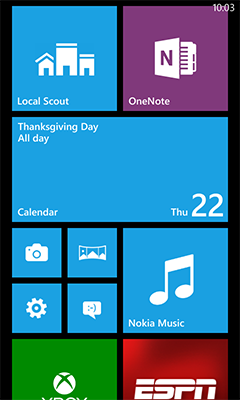
Windows Phone 8 is the second generation of the Windows Phone mobile operating system from Microsoft. It was released on October 29, 2012, and, like its predecessor, it features a flat user interface based on the Metro design language. It was succeeded by Windows Phone 8.1, which was unveiled on April 2, 2014.
Microsoft mobile services are a set of proprietary mobile services created specifically for mobile devices; they are typically offered through mobile applications and mobile browser for Windows Phone platforms, BREW, and Java. Microsoft's mobile services are typically connected with a Microsoft account and often come preinstalled on Microsoft's own mobile operating systems while they are offered via various means for other platforms. Microsoft started to develop for mobile computing platforms with the launch of Windows CE in 1996 and later added Microsoft's Pocket Office suite to their Handheld PC line of PDAs in April 2000. From December 2014 to June 2015, Microsoft made a number of corporate acquisitions, buying several of the top applications listed in Google Play and the App Store including Acompli, Sunrise Calendar, Datazen, Wunderlist, Echo Notification Lockscreen, and MileIQ.

The Nokia Lumia 820 is a smartphone designed, developed and marketed by Nokia. It is the successor to the Lumia 800 and is one of the first Nokia phones to implement Windows Phone 8 alongside the Nokia Lumia 920. Although sharing a similar appearance with the Lumia 800, the Lumia 820 is a major overhaul over its predecessor, sporting a 4.3 inches (110 mm) diagonal OLED display with scratch resistant glass, though lacking Gorilla Glass protection, 1.5 GHz dual-core processor, and an 8.7-megapixel camera. The phone will come with LTE connectivity and a wireless-charging option. The 820 is the first Nokia Windows Phone OS based smartphone to embed a microSD card slot.
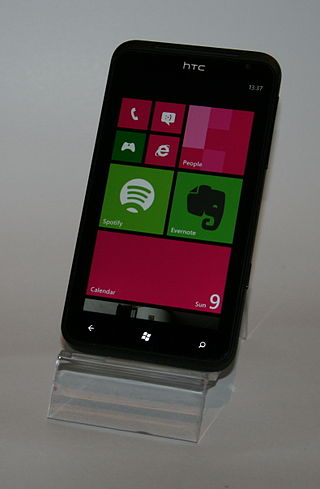
Windows Phone 7 is the first release of the Windows Phone mobile client operating system, released worldwide on October 21, 2010, and in the United States on November 8, 2010. It runs on the Windows CE 6.0 kernel.

The Nokia Lumia 720 is a Windows Phone 8 device manufactured by Nokia. It was announced at the 2013 Mobile World Congress.

Lumia imaging apps are imaging applications by Microsoft Mobile and formerly by Nokia for Lumia devices built on the technology of Scalado. The Lumia imaging applications were notably all branded with "Nokia" in front of their names, but after Microsoft acquired Nokia's devices and services business the Nokia branding was superseded with "Lumia", and often updates included nothing but name changes, but for the Lumia Camera this included a new wide range of feature additions. Most of the imaging applications are developed by the Microsoft Lund division. As part of the release of Windows 10 Mobile and the integration of Lumia imaging features into the Windows Camera and Microsoft Photos applications some of these applications stopped working in October 2015.

Cortana was a virtual assistant developed by Microsoft that used the Bing search engine to perform tasks such as setting reminders and answering questions for users.
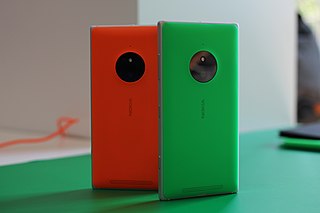
The Nokia Lumia 830 is a smartphone developed by Microsoft Mobile and branded as "Nokia" that runs Microsoft's Windows Phone 8.1 operating system. It was announced on September 4, 2014 at Internationale Funkausstellung Berlin and released in October 2014. It is a successor to the 2012 Nokia Lumia 820 and marketed as an "affordable flagship".
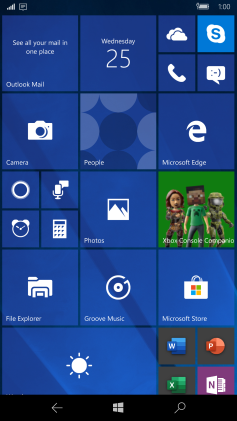
Windows 10 Mobile was a mobile operating system developed by Microsoft. First released in 2015, it is a successor to Windows Phone 8.1, but was marketed by Microsoft as being an edition of its PC operating system Windows 10.
Windows 10 introduced a number of new elements, including the option to use a touch-optimized interface or a traditional desktop interface similar to that of Windows 7 along with live tiles from Windows 8. However, unlike previous versions of Windows, where most, if not all, major features for that release were completed by its RTM, Windows 10 continues to receive major features and changes beyond its initial release to market. Microsoft describes Windows 10 as an "operating system as a service" that will receive ongoing updates to its features and functionality. This is supplemented with the ability for enterprise environments to receive non-critical updates at a slower pace, and to use long-term support milestones that will only receive critical updates, such as security patches, over their ten-year lifespan of support.

Action Center is a notification center included with Windows Phone 8.1, Windows 10 and Windows 10 Mobile. It was introduced with Windows Phone 8.1 in July 2014, and was introduced to the desktop with the launch of Windows 10 on July 29, 2015.

Microsoft Lumia 950 is a smartphone developed by Microsoft, officially revealed on 6 October 2015 alongside the larger Lumia 950 XL. The phone was first released on AT&T in the United States on 17 November 2015, and subsequently made available on the Microsoft Store as well as in other countries.

The Microsoft Lumia 950 XL is a smartphone developed by Microsoft, officially revealed on October 6, 2015 and released on November 20, 2015 alongside the smaller Lumia 950. The Lumia 950 XL is the successor to the Nokia Lumia 1520 and is among the first phones to natively run Windows 10 Mobile. The phone is primarily aimed at users desiring a flagship device, in contrast to Microsoft's previous strategy of targeting developing markets with low-end hardware.


